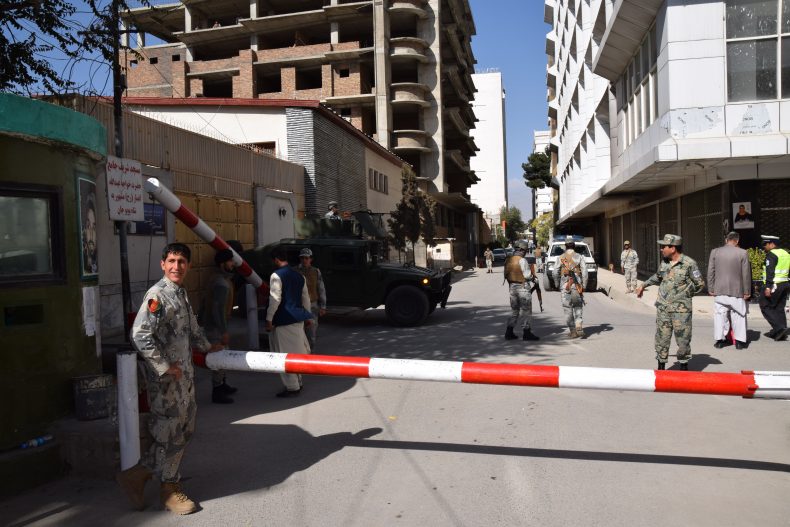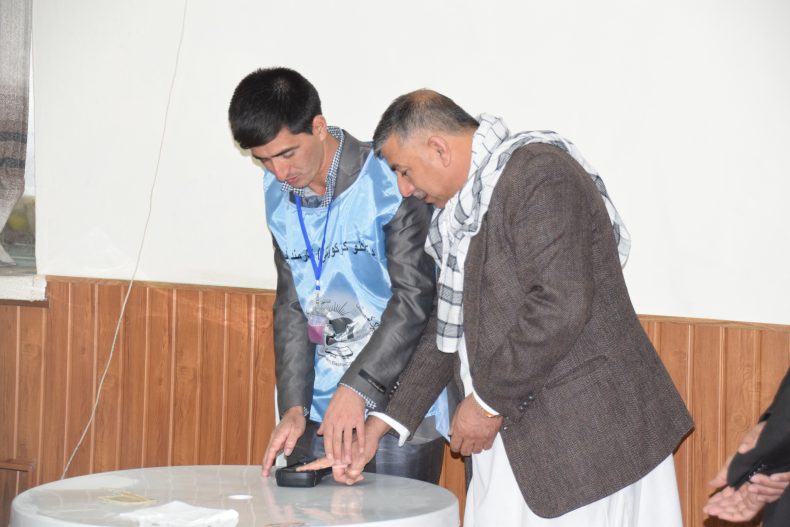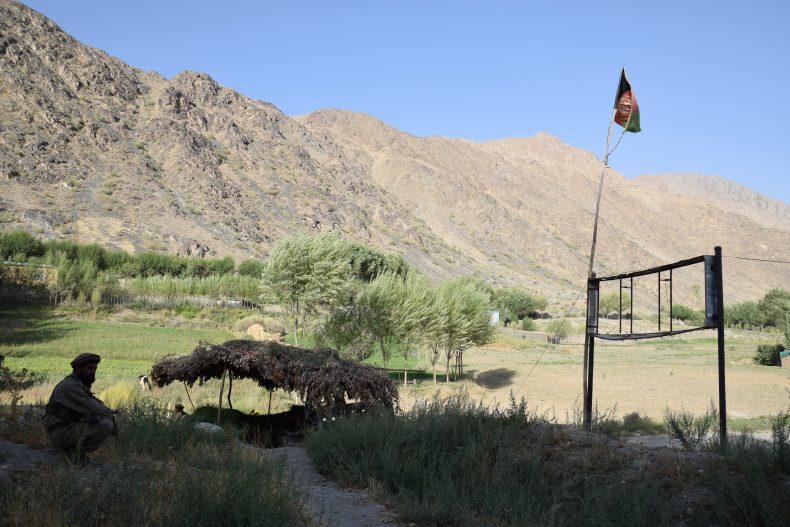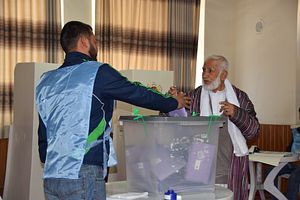KABUL, Afghanistan – On October 20, Afghanistan held its long overdue parliamentary elections. Delayed since 2015, the polls were only the third since the ousting of the extremist Islamist Taliban regime in the wake of the 9/11 attacks in 2001. While voter turnout in Kabul and other cities was reportedly high, the election was spoiled by technical and organizational problems at some of the 4,900 polling stations across the country. Contrary to large populations centers, where security was – for Afghan standards – relatively good, insurgent attacks severely hampered, if not prevented, voting in some more remote areas. These disruptions open the door even further for – justified or not – criticism of the results (preliminary results are scheduled to be announced on November 10).
The Diplomat visited two polling centers in Kabul’s Shahr-i Naw, a neighborhood in the center of the Afghan capital only a few minutes’ walk away from heavily guarded ministries and embassies. Both opened as scheduled on the morning of October 20. Voters arrived alone or in small groups and entered the stations, which were – like many around the country – located in mosques guarded by a number of police officers. Across Afghanistan, reportedly 70,000 government forces were deployed to ensure the security of the elections.

The increased police presence near polling stations in Kabul was noticeable. Photo by Franz J. Marty.
After casting their ballots, several voters told The Diplomat that they had found a good candidate to vote for. Across Afghanistan, about 2,500 candidates vied for the 250 seats of the Wolesi Jirga, the lower house of Afghanistan’s bicameral National Assembly. Voters also said that they were hopeful that their ballot would make a difference. People that had already voted were easily recognizable by a purple fingertip – colored by an ink that is one of several mechanisms meant to prevent double voting.
“The elections are beneficial, because that’s the way to fix our homeland,” Hussain, a neatly dressed elder, said after casting his vote. Nureddin, a young man who works in a nearby motorcycle store explained: “To vote is not only one’s right, but also one’s obligation.”
“It is good that the election is taking place, but the process is not organized well,” Mohammad Naim Haqmal, a candidate that also just had voted, stated, foreshadowing what happened at other polling centers during the day.
Unorganized and Closed Polling Stations
“In the morning, I went to the polling center [in Kabul] where I have registered. But they said that they don’t have the electoral materials ready,” Nawab Mumand, a local journalist said. “I waited for about two hours, but nothing happened, so I left.” Similar things reportedly occurred in several polling centers across the country, with Afghan TV stations showing footage of crowds waiting in front of closed polling centers.
Some of the centers opened later, others – such as the one Mumand had gone to – not at all.
By around noon, Afghanistan’s Independent Election Commission, which is responsible for organizing the election, announced that voting in centers that opened late would continue until 8 p.m. local time, instead of the planned closing at 4 p.m. Centers that did not open until 1 p.m. (according to the Independent Election Commission, 401 centers ) were ordered to reopen the next day (October 21).
In centers that were operating, some people complained that their names were not on the voter list – despite claiming to have registered and showing a registration confirmation sticker attached to their tazkera (a national ID document, consisting of a single sheet of paper) as apparent proof.
In some polling stations the devices to register voters biometrically, meant to prevent double voting, reportedly did not function properly. In others, the machines allegedly worked, but the election staff had trouble handling them. The machines, which register fingerprints and portrait photos, were introduced at the last minute to assuage the political opposition. That meant there had been very little time to train staff on the devices — or to test them, for that matter.

The new biometric equipment included fingerprint scanning to identify voters. Photo by Franz J. Marty.
Afghanistan’s Electoral Complaints Commission stated in a press conference in the afternoon of October 20 that these issues “seriously call into question the transparency and fairness of the elections.”
On October 21, voting resumed at some polling centers that were closed on election day — others were unable to open due to insecurity, though it hasn’t been definitively determined how many. As of 4 p.m. local time, there were no reports of major incidents. While some of the aforementioned technical and organizational troubles persisted into the second day, including in the center in Kabul, Mumand finally was able to cast his vote.
Alleged High Voter Turnout Despite Insecurity
In a stark contrast to such problems, officials and independent election observers alike praised the allegedly high voter turnout. According to initial figures of the Independent Election Commission, more than 3 million out of around 8.8 million registered voters had cast their ballots on October 20. It is unclear whether this number reflected prolonged voting in some polling centers on election day. The final turnout number is certainly bound to change, as the before mentioned figure does not yet include the delayed voting on October 21. In this context, it should be kept in mind that the Afghanistan Analysts Network warned before the elections that the voter lists themselves remain questionable, with several provinces allegedly showing implausibly high numbers. Nonetheless, footage of crowds of Afghans eagerly waiting to vote raised hope for Afghanistan’s young democracy.
That crowds would turn out to vote was anything but self-evident. “I don’t vote, as it is useless”; “The current members of parliament as well as the new candidates are all thieves”; “There is not one single good candidate among all of them” — these are only a few statements that The Diplomat heard from Afghans in the days preceding the election. A large portion of the estimated 15 million eligible voters did not even bother to register. In a country where corruption among officials and politicians is reportedly rampant this does not come as a surprise. Furthermore, it doesn’t help that the Single-Non-Transferable Voting system means that the elected candidates usually only represent a small fraction of all votes, with the rest of ballots having no direct impact (this is especially the case in a populous and prominent province like Kabul, where over 800 candidates contested 33 seats).
Then there are, of course, the security threats. In the days before the elections, the Taliban asked Afghans to abstain from voting, as they termed the election a plot of American “invaders” and, therefore, resistance to it an alleged religious duty. The Taliban also implicitly threatened eligible voters, with one communiqué asking people to remain indoors on election day as the Taliban – who vowed to leave no stone unturned to prevent the election – claimed to “not want to harm any common Afghan.” In a country with frequent insurgent attacks that kill record high numbers of civilians, and where in the months prior to the elections 10 candidates were killed, such threats are not to be taken lightly.
“If you vote, you risk being blown up by a suicide attacker in a polling station,” one Kabuli explained.
In an example of the tense security situation, the election in the province of Kandahar was postponed at the last minute, after the Taliban claimed an attack conducted on October 18, in which an Afghan guard opened fire on provincial officials in the highly secured compound of the governor of Kandahar. The incident killed Kandahar’s police chief, General Abdul Raziq, who is infamous well beyond his province, as well as the provincial chief of the National Directorate of Security (NDS), Afghanistan’s secret police; the governor, two other high ranking Afghan officers, and three members of the international military coalition were reportedly wounded. U.S. Army General Austin S. Miller, the commander of U.S. Forces-Afghanistan and the NATO-led Resolute Support Mission, was also on scene, but remained unharmed.
Before the incident in Kandahar, the election in the province of Ghazni, whose capital the Taliban had assaulted in mid-August, was postponed, although this was not only due to security, but also politics. Furthermore, the election was cancelled in several districts and polling stations of various provinces across the country due to the high levels of insecurity. Hence, the roughly 4,900 operating polling centers represented only about two-thirds of the reported total of 7,336 polling stations that would be necessary to cover the whole country.
In view of the above, election day passed – by Afghan standards and at least in population centers – comparatively quietly. Wais Ahmad Barmak, Afghanistan’s minister of interior affairs, was quoted as saying that insurgents had conducted 192 attacks across the country; this could not be independently verified, but would be less than expected. The only major incident was an explosion near a polling center in an outer neighborhood of Kabul that was reportedly caused by a suicide bomber and killed at least 15 people and wounded 20 more. There were also other minor explosions in Kabul on election day. The Afghanistan Analysts Network indicated that mortar and rockets hit the outskirts of Kunduz, the capital of the northern province with the same name, on the morning of election day; at least three people were killed and 39 wounded.
Adding all the incidents together, nonetheless, leads to a tragic number of casualties among civilians and security forces.

Remote Baharak district in Badakhshan, late August 2018. Photo by Franz J. Marty.
What Happened in the Hinterlands?
To assess the security situation and voter turnout during election day in more remote areas is more difficult.
The Taliban claimed to have conducted an array of attacks across Afghanistan on October 20 (a summary statement indicated 407 alleged attacks), blocking roads and allegedly preventing the elections in countless districts, if not nearly whole provinces. While such Taliban propaganda is usually vastly exaggerated and sometimes even made up, some of the incidents – as well as the fact that they severely hampered the elections – have been confirmed.
For example, the Taliban claimed to have blocked all roads and at least two polling stations in the remote district of Roghiston in the mountainous northeastern province of Badakhshan.
Mudir Haiot, the NDS chief for Roghiston and leader of a local armed anti-Taliban uprising, confirmed to The Diplomat by telephone that the Taliban, who have long controlled parts of Roghiston, launched attacks in the district at around 7 a.m. on election day – exactly when the polling stations were (at least in theory) supposed to open. Haiot stated that polling centers in Roghiston were nevertheless open, but that most residents were unable to get to the stations due to the fighting. Hence, although the skirmishes apparently only caused two fatalities and one wounded among (pro-)government forces and reportedly similar casualties on the insurgency side, this severely impeded the election in Roghiston. The events in Roghiston were corroborated by a second source.
In another example, a commander of the Afghan Local Police from the district of Imam Soheb in the province of Kunduz told The Diplomat that Taliban attacks the night before and in the early morning hours of election day led to the closure of at least four polling stations near the district center. The closed polling stations were unable to open the next day, as fighting had resumed, the commander said — another source corroborated the commander’s account.
The Afghanistan Analysts Network noted similar incidents from districts in the provinces of Maidan Wardak, Logar, Paktia, and Takhar. Afghan news agency Pajhwok reported election-related security incidents from across the country, although their impact on the election was not immediately clear.
However, not all such Taliban efforts yielded results. An insurgent assault from the Taliban-held district of Warduj to the government-controlled district of Baharak, both in Badakhshan, was – according to three local sources that The Diplomat spoke to – swiftly repelled. The sources disagreed on the voter turnout in Baharak, with one alleging that many people voted and another saying that turnout had been low. In Warduj, which the Taliban has fully controlled since October 2015, there was no election.
While constituencies in such remote areas are few in numbers and might therefore not be that significant, the situation raises questions about the representativeness of the parliamentary elections.
This inconsistency of election experience — between major population centers and more rural districts — as well as the aforementioned technical and organizational problems open the door for fraud allegations that could undermine any election result.

An elder displays his ink-marked finger after casting his ballot in Kabul. Photo by Franz J. Marty.
Franz J. Marty is a freelance journalist based in Afghanistan. While he writes on broad range of topics, he focuses on military and security issues. You can follow him on Twitter at @franzjmarty.

































